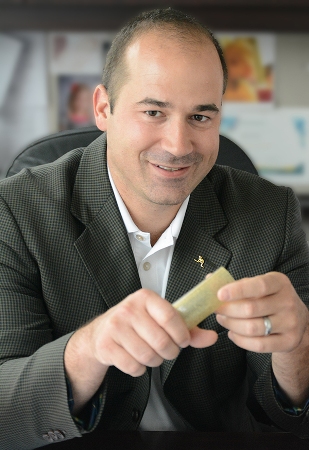Matthew Becker, professor of polymer science and biomedical engineering in the University of Akron, has received a $390,000 NSF grant to develop 3D-printed biodegradable polymer scaffolds. These scaffolds are the frameworks within which bone will grow and may change the face of craniofacial reconstruction.
 Dr. Matthew Becker, professor of polymer science and biomedical engineering (Credit. Lauren Collins)
Dr. Matthew Becker, professor of polymer science and biomedical engineering (Credit. Lauren Collins)
The surface of the polymer material is functionalized with proteins and peptides to stimulate bone generation. Imagine an infantry solder with a gunshot wound that shattered his jaw or a person born with a birth defect such as a missing nose. The absent bone is replaced by new bone, which grows on a polymer scaffold custom-designed via 3-D printing according to a patient’s own MRI and CT scanned images.
The new bone is developed from a polymer scaffold that is custom-designed with the help of a 3D printing method, based on MRI and CT scanned images of the patient. When a reconstructive surgeon places the polymer scaffold beneath the skin, the scaffold is broken into carbon dioxide, amino acids and normal body metabolites as the new bone begins to set.
Becker said that the biodegradable polymer scaffolds are readily available with functional groups present on the surface. These functional groups can be added with peptides and proteins to form new bone. Although creation of such scaffolds have been attempted in previous studies with 3D printing technology, different polymer materials have not been used in the filament feed stocks. This, in turn, minimizes the chance to access chemical and physical properties stimulating the growth of bone.
Recently we’ve discovered a combination of peptide concentrations capable of accelerating human mesenchymal stem cell differentiation into bone. We are now working on translating these peptides to our 3-D printed scaffolds without additives to make them functional exclusively on the surface, where the bone growth is necessary for head- and neck-injury applications.
Becker
Becker also expects that this research will pave the way for technology on which clinical trials can be performed. He foresees the generation of favorable and extraordinary results from this research, i.e., development of mechanically strong replaced bone with a shortened healing period and reduced inflammation.
Soldiers and others survivors with traumatic injuries that leave them without a portion of their face, that’s a tough life to live. What we’re developing is the promise of a readily made and applied breakthrough medical solution that has life-changing potential for people who previously had no such option.
Becker
References